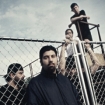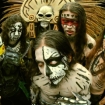Cemican translates to "the duality of life and death" in Nahuatl, a language spoken by roughly two million people in Central Mexico. And it's a fitting name for a band whose music, visual presentation and live shows highlight the "transportation to true life and joy" of slain warriors as they seek to enter the mythological Aztec realms of Tlālōcān or Mictlān. Onstage, the Mexican troupe acts out that mythology: dressing in armor and face paint, recruiting fans for simulated "sacrifices." That full sensory experience is part of what grabbed European audiences at festivals like Wacken in Germany and Hellfest in France.
"The original idea with Cemican's music [was that] the visual was also on par: the dances, battles and sacrifices," drummer Tlipoca tells us through a translator. "That all the armor of the warriors be [shown] so that the public could be transported to pre-Hispanic Mexico. That is why sacrifice and performance onstage are essential. Our shaman or sorcerer, Xaman-ek, is the one in charge of offering the gods the heart of his victim. He is a crucial part of our show. In fact, throughout the concerts people begin to shout 'sacrifice!' because they want to see the blood of the one who will be sacrificed. It is phenomenal when that moment arrives because the public is so excited that it seems they want to eat the heart of the sacrificed person themselves."
Cemican's unwavering goal is to "let everyone hear the mystical sounds of death." Within and beyond their theatrical live shows, the Mexican sextet pursues that mission brilliantly, weaving brutal metal riffery with indigenous, pre-Hispanic instrumentation (flutes, rattling percussion) and lyrics exploring the often-morbid myths and legends of Aztec and Mayan culture. Tlipoca, who previously played in death- and black-metal bands, co-founded Cemican in 2008 with vocalist-guitarist Tecuhtli, a high-school friend with a past in prog and power metal. Since many of their favorite artists explore specific cultural themes, the duo decided to follow suit. "One day we asked ourselves: If Amon Amarth talks about Vikings, Eluveitie about Celts, Týr from Norse mythology, why don't we make a band that talks about the myths and legends of the Aztecs and Mayans?" the drummer recalls. "And so we rescued the ancient sounds and incorporated the Nahuatl and Mayan language in the songs."
Little known outside of their homeland for much of their tenure, Cemican have received a serious boost in recent years due to tours with Eluveitie and Rotting Christ, U.S. airplay on SiriusXM's Liquid Metal channel, viral YouTube views and the seal of approval from Adult Swim's taste-making singles series, which premiered a new song, "Yóok 'ol kaab Maya" ("Our Mayan Universe"), amid its 2020 rollout. It helps, too, that Cemican's third and latest album, 2019's In Ohtli Teoyohtica in Miquiztli, is their most ambitious and fully realized yet — take "Luna Desmembrada," which features a stirring female vocal over a bed of snaking percussion, tumbling tom-toms, stacked chants and growls, pummeling riffs, lyrical flute lines and tasty arena-metal guitar melodies. It's the sound of a band ready to take on the world. "We carry in the blood the warrior Mexica and the ancient sounds," Tlipoca proclaims. "We have the charge of the gods to bring our music and the glory of ancient Mexico to the entire world, as well as the songs [of] death that will awaken the true gods."
Despite the supernatural force of their calling, the drummer admits that some early audiences weren't sure what to make of Cemican's idiosyncratic style. "The first presentations were not so well accepted, but not rejected either," he recalls. "There was that thorn of doubt [but also] curiosity to listen and see how ancient sounds mixed with the power of metal."
The band also encountered numerous technical obstacles as they learned how to combine their traditional folk and modern rock instruments. "At first it was a complete problem because the engineers did not know how to get the sounds balanced in the shows," Tlipoca says. Recording in the studio presented a similar hurdle, as evidenced by the muddy mix of their first two LPs, 2009's Ometiliztli and 2012's Estamos en el Valle de los Muertos Ticateh Ipan Miquixtlahuac.
Cemican are currently plotting their fourth album for 2022, with their Adult Swim single serving as a compelling stopgap. The group's inclusion in the series was particularly exciting for Tlipoca not only because he considers the network's popular animated series Rick & Morty to be "genius" but also because of the track's subject matter: the construction of the Mayan empire, its "sacred temples and people," and a whole lot more.

"There is also talk of contact with the stars in the astral journey with non-Earthly beings, assistants to creation, and that men were given the power to create, die and reincarnate — also to dominate eclipses and walk with the jaguar," he says of "Yóok 'ol kaab Maya." "The four elements of life are mentioned: water, fire, wind and earth as part of light and mysticism. We are inspired by the beginning and strength of a thousand-year-old culture of intelligence, which is based on the worldview of origin."
Some fans will take the deep dive into Cemican's mythological themes. Others, without the aid of lyrical translation, will be content to indulge in their unique cultural hybrid. A small portion will probably stick around because, well, simulated onstage sacrifice is pretty cool. Whatever draws people to the band, Cemican are steadfast in their direction and feel like they have yet to scratch the surface. "[This] is definitely our style," Tlipoca concludes. "And we will not change it."








